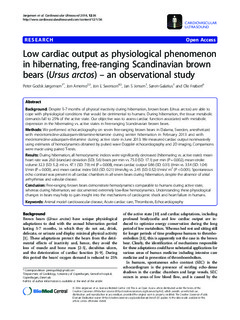| dc.contributor.author | Jørgensen, Peter Godsk | |
| dc.contributor.author | Arnemo, Jon Martin | |
| dc.contributor.author | Swenson, Jon E. | |
| dc.contributor.author | Jensen, Jan S. | |
| dc.contributor.author | Galatius, Søren | |
| dc.contributor.author | Frøbert, Ole | |
| dc.date.accessioned | 2015-02-19T08:53:20Z | |
| dc.date.available | 2015-02-19T08:53:20Z | |
| dc.date.issued | 2014 | |
| dc.identifier.citation | Jørgensen et al. (2014). Low cardiac output as physiological phenomenon in hibernating, free-ranging Scandinavian brown bears ( Ursus arctos ) : an observational study. Cardiovascular Ultrasound 2014, 12 :36 http://www.cardiovascularultrasound.com/content/12/1/36 | nb_NO |
| dc.identifier.uri | http://hdl.handle.net/11250/276712 | |
| dc.description.abstract | Background:
Despite 5-7 months of physical inactivity during hibernation, brown bears (Ursus arctos) are able to
cope with physiological conditions that would be detrimental to humans. During hibernation, the tissue metabolic
demands fall to 25% of the active state. Our objective was to assess cardiac function associated with metabolic
depression in the hibernating vs. active states in free-ranging Scandinavian brown bears.
Methods:
We performed echocardiography on seven free-ranging brown bears in Dalarna, Sweden, anesthetized
with medetomidine-zolazepam-tiletamine-ketamin
e during winter hibernation in February 2013 and with
medetomidine-zolazepam-tiletamine during active state in June 2013. We measured cardiac output noninvasively
using estimates of hemodynamics obtained by pulsed wave Doppler echocardiography and 2D imaging. Comparisons
were made using paired T-tests.
Results:
During hibernation, all hemodynamic indices were significantly decreased (hibernating vs. active state): mean
heart rate was 26.0 (standard deviation (SD): 5.6) beats per min vs. 75.0 (SD: 17.1) per min (P = 0.002), mean stroke
volume 32.3 (SD: 5.2) ml vs. 47.1 (SD: 7.9) ml (P = 0.008), mean cardiac output 0.86 (SD: 0.31) l/min vs. 3.54 (SD: 1.04)
l/min (P = 0.003), and mean cardiac index 0.63 (SD: 0.21) l/min/kg vs. 2.45 (SD: 0.52) l/min/ m
2
(P < 0.001). Spontaneous
echo contrast was present in all cardiac chambers in all seven bears during hibernation, despite the absence of atrial
arrhythmias and valvular disease.
Conclusion:
Free-ranging brown bears demonstrate hemodynamics comparable to humans during active state,
whereas during hibernation, we documented extremely low-flow hemodynamics. Understanding these physiological
changes in bears may help to gain insight into the mechanisms of cardiogenic shock and heart failure in humans | nb_NO |
| dc.language.iso | eng | nb_NO |
| dc.publisher | Cardiovascular Ultrasound | nb_NO |
| dc.subject | Animal model cardiovascular disease, | nb_NO |
| dc.subject | Acute cardiac care | nb_NO |
| dc.subject | Thrombosis | nb_NO |
| dc.subject | Echocardiography | nb_NO |
| dc.title | Low cardiac output as physiological phenomenon in hibernating, free-ranging Scandinavian brown bears ( Ursus arctos ) : an observational study | nb_NO |
| dc.type | Journal article | nb_NO |
| dc.type | Peer reviewed | nb_NO |
| dc.source.volume | 12 | nb_NO |
| dc.source.journal | Cardiovascular Ultrasound | nb_NO |
| dc.source.issue | 36 | nb_NO |
| dc.identifier.doi | 10.1186/1476-7120-12-36 | |
